What Is A 1935 Mercury Dime Made Out Of?
Mercury (Winged Liberty Head) dimes first appeared in 1916, and after a break in production in 1932 and 1933, the US Mint continued to produce them until 1945.
Many collectors regard these coins as the most exquisite and desirable in US Mint history.
It’s interesting to note that Americans have loved dimes since the first day they were minted. As a result, this series is included in many collections across the US.
The Mercury dimes were created by engraver Adolph Weinman in 1916 to replace the Barber (Liberty head) dimes that had been produced from 1892.
Despite being used up to 1945, only the coins made between 1916 and 1931 are uncommon.
In 1916, a design competition was held by the Treasury Department as part of its decision to replace Barber dimes. Robert Woolley, the director of the US Mint, declared on March 3 that Weinman’s drawing of Lady Liberty with wings and a Phrygian cap on her head had won.
Although most Americans assumed their new coin featured the Roman god Mercury, its wings represented the freedom of thinking.
Along the top coin rim, the word LIBERTY is visible. The date and the slogan “IN GOD WE TRUST” are likewise found on the obverse.
On the reverse, Roman fasces stood for strength, while an olive branch encircling them meant peace. Along the coin’s rim, the words E PLURIBUS UNUM was inscribed in Latin, along with the denomination and the words UNITED STATES OF AMERICA. The coin features an edge of 118 reeds.
The majority of collectors think that Weinman based the Liberty artwork on a portrait of Wallace Stevens’ wife. Additionally, several elements resemble an allegorical Victory sculpture in Baltimore.
Despite having a face value of 10 Cents, the intrinsic metal value of the 1935 Dime is actually far more thanks to a 90% Silver and 10% Copper composition. The coin weighs 0.07234 ounces (2.5 g) and has a weight of 0.723 of .999 pure silver.
1935 Mercury Dime Varieties
1935 Mercury Dime with No Mint Mark
Year: 1935
Face Value: $0.10
Composition: 90% Silver, 10% Copper
Total Weight: 0.07234 ounces (2.5 g)
Diameter: 0.70472 inches (17.9 mm)
Thickness: 0.05315 inches (1.35 mm)
Edge: 118 Reeds
Minted in: Philadelphia
Quantity Minted: 58,830,000
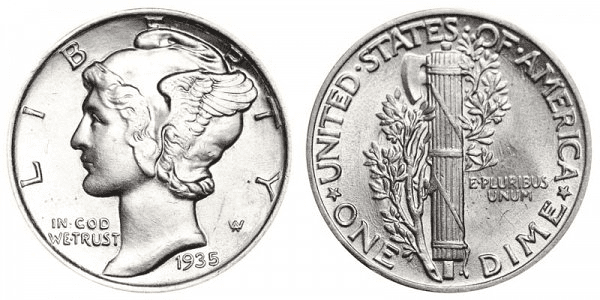
1935 S Dime
Year: 1935
Face Value: $0.10
Composition: 90% Silver, 10% Copper
Total Weight: 0.07234 ounces (2.5 g)
Diameter: 0.70472 inches (17.9 mm)
Thickness: 0.05315 inches (1.35 mm)
Edge: 118 Reeds
Minted in: San Francisco
Quantity Minted: 15,840,000
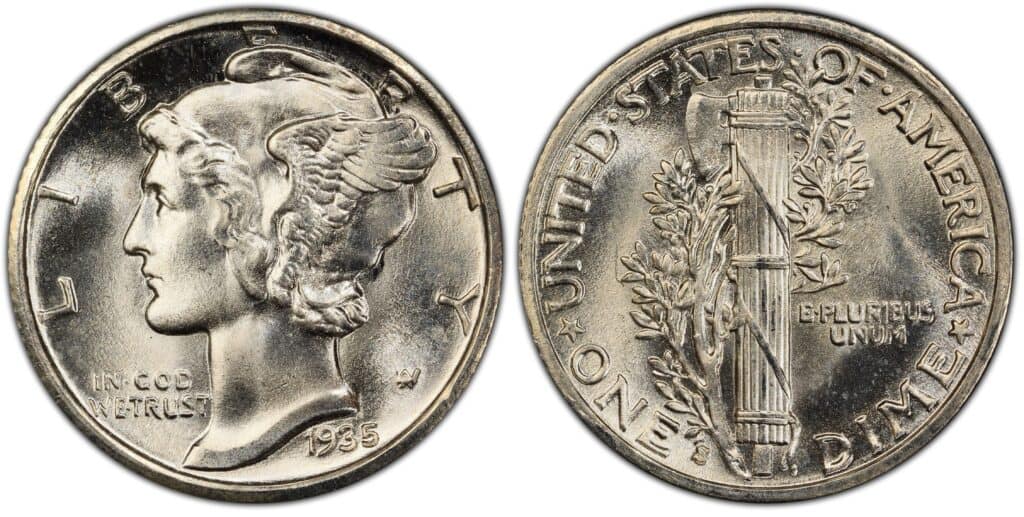
1935 D Dime
Year: 1935
Face Value: $0.10
Composition: 90% Silver, 10% Copper
Total Weight: 0.07234 ounces (2.5 g)
Diameter: 0.70472 inches (17.9 mm)
Thickness: 0.05315 inches (1.35 mm)
Edge: 118 Reeds
Minted in: Denver
Quantity Minted: 10,477,000

1935 W Dime
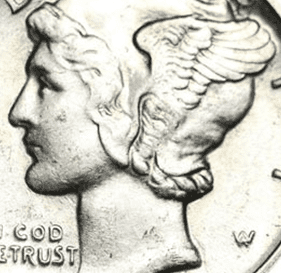
Many coin collectors are curious about the “W” symbol on their Mercury Dimes and want to know what it represents. Many newcomers mistakenly think their Mercury Dimes have a W mint mark but are perplexed when they learn that a W mint mark didn’t first appear on American coins until 1984, nearly 40 years after the last Mercury Dime was released from the presses.
This little W, which can be seen on the lower right side of the obverse between the date and the letter “Y” of “LIBERTY,” is actually a monogram with the letters “A” and “W,” which stands for Adolph A. Weinman, the coin’s creator. Many coin collectors don’t find the “A” entwined with the “W” at the bottom centre until they attentively examine the coin’s obverse with a 5X or 10X coin magnifier.
Mint marks can be found on the reverse of Mercury Dimes, which were issued from 1916 to 1945, in the lower-left corner of the field by the rim, just to the right of the “E” in “ONE,” and beneath the main portion of the olive branch.
List of Errors
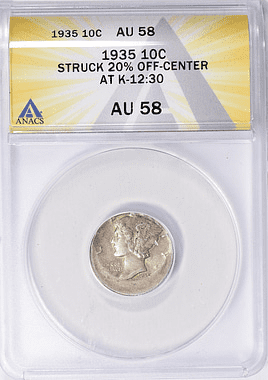
There are no errors intrinsic to the 1935 Mercury Dime, and instead, the errors seen in this year of mintage run on a coin-by-coin basis as exemplified by the coin seen above which has been struck off center. Other common errors include clipped planchets, doubled die errors, and strikethrough errors.
1935 Dime Full Split Bands
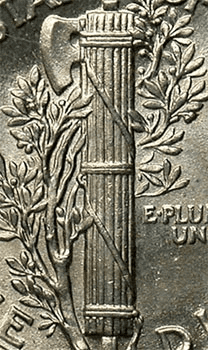
The term “Full Split Bands” or “Full Bands” is used to grade Mercury Dimes, which often have forceful strikes and complete design elements. Collectors avidly seek out these coins, which are worth more than counterparts without Full Bands.
The two center, horizontal bands that hold the fasces together are a focal point of the Mercury Dime’s reverse design. The two bands will be completely separated on well-struck samples from a pair of well-defined dies. The split won’t be noticeable on coins that were poorly struck or made using worn dies.
There cannot be a break in the bands caused by a weak strike, contact marks, or planchet issues for them to be considered “Full Split Bands.”
How Much Is A 1935 Mercury Dime Worth Today?
As of June 2022, the 1935 Mercury Dime coin has a melt value of $1.54 of silver. The silver spot price of $21.31 per ounce is used to determine this melt value.
1935 Dime Value
| Grading | 1935 | 1935 S | 1935 D |
| Good | $ 1.94 | $ 2.10 | $ 2.10 |
| Very good | $2 | $2.2 – $2.30 | $2.2 – $2.30 |
| Fine | $2.30 | $2.60 | $2.60 |
| Very fine | $3.20 – $3.40 | $3.20 – $3.40 | $3.20 – $3.40 |
| Extra fine | $ 3.80 | $5 – $7.20 | $9 – $14.40 |
| AU | $4 – $5.10 | $7 – $16.80 | $19 – $30 |
| MS 60 | $7 – $7.20 | $18 – $21.60 | $28 – $33.60 |
| MS 61 | $7 – $7.20 | $19 – $22.80 | $30 – $36 |
| MS 62 | $7 – $8 | $20 – $24 | $32 – $38.40 |
| MS 63 | $ 9 | $22 – $26.40 | $35 – $42 |
| MS 64 | $13 – $15.60 | $26 – $31.20 | $45 – $54 |
| MS 65 | $17 – $22 | $27 – $32.40 | $70 – $84 |
| MS 66 | $40 – $48 | $60 – $72 | $130 – $156 |
| MS 67 | $85 – $102 | $240 – $276 | $550 – $632.50 |
What Is The Rarest Mercury Dime?
The 1916-D Mercury Dime, the 1921 and 1921-D Mercury Dimes, the 1925-D Mercury Dime, the 1926-S Mercury Dime, the 1931-D Mercury Dime, and 1942 over 41 and 1942 over 41-D Mercury Dime variations are the rarest coins in the series. Although these coins are more difficult to find, they are all accessible in low grades, and difficult to find but still obtainable in high grades.
The most valuable Mercury Dime ever sold was a 1938-S Mercury Dime which sold for $364,250.
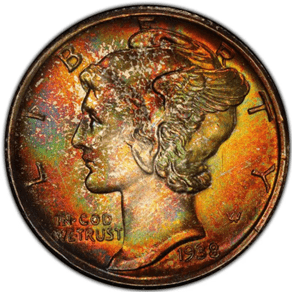
Although several 1938-S Mercury Dimes were produced, this particular dime featured a distinctive design. In addition to being of the best quality, this coin had a stunning array of iridescent colours that made it incredibly rare and valuable.
How Coins are Graded
The Sheldon Scale is used by numismatists to provide a numerical value to coins. The Sheldon Scale goes from poor (P-1) to perfect mint state (P-1) (MS-70). Coins were originally evaluated using words to reflect their condition (Good, Fair, Excellent, Etc.). Unfortunately, coin collectors and dealers had different ideas about what each of these terms represent.
Professional numismatists joined together in the 1970s and established CoinGrading standards. These numismatists now assign grades at key places on the seventy-point scale, using the most regularly utilized numeric points in conjunction with the original adjective grade. The following are the most common coin grades:
- (P-1) Poor – Indistinguishable and probably damaged; if used, must have a date and mintmark; otherwise, rather battered.
- (FR-2) Fair – Nearly smooth, but without the damage that a coin graded Poor often possesses. The coin must have enough detail to be identified.
- (G-4) Fair – Inscriptions have merged into the rims in some areas, and important elements have been mostly erased.
- (VG-8) Very Good- A little weathered, but all of the primary design elements are visible, albeit faintly. There is little if any, central detail left.
- (F-12) Good – The item is very worn, yet the wear is even, and the overall design details stand out clearly. Rims are almost completely isolated from the field.
- (VF-20) Very Fine – Moderately weathered, with some finer features still visible. The motto or all letters of LIBERTY are readable. Both sides of the coin have entire rims that are separated from the field.
- (EF-40) Extremely Fine – Gently used; all gadgets are visible, and the most important ones are bold. The finer details are bold and clear, however, light wear may be seen.
- (AU-50) Uncirculated – Slight evidence of wear on the coin’s design’s high points; may have contact marks; eye appeal should be adequate.
- (AU-58) Uncirculated Choice – Slight traces of wear, no severe contact marks, almost full mint shine, and great eye appeal.
- (MS-60) Mint State Basal – Strictly uncirculated; no indication of wear on the coin’s highest points, but an unsightly coin with reduced luster, visible contact marks, hairlines, and other flaws.
- (MS-63) Mint State Acceptable – Uncirculated, but with contact scratches and nicks, little reduced shine, but otherwise appealing appearance. The strike is weak to average.
- (MS-65) Mint State Choice – Uncirculated with great mint shine, very little contact blemishes, and exceptional eye appeal. The strike is unusually severe.
- (MS-68) Mint State Premium Quality – Uncirculated with superb luster, no obvious contact marks to the naked eye, and exceptional eye appeal. The strike is quick and appealing.
- (MS-69) Almost Perfect Mint State – Uncirculated with perfect brilliance, a sharp and appealing strike, and extremely good eye appeal. A near-perfect coin with minor imperfections in the planchet, strike, and contact markings (seen only under 8x magnification).
- (MS-70) Mint State Perfect – Under 8x magnification, there are no tiny imperfections discernible; the strike is crisp, and the coin is perfectly centered on a beautiful planchet. Rarely seen on a coin, this coin is bright and whole, with original luster and exceptional eye appeal.
Where To Buy Or Sell 1935 Dimes?
As you can see from the chart above, there can be some pretty nice value in even the lower-grade 1935 Dimes. For coins of a lower grade, there is a strong market on sites such as eBay and Etsy, where these coins can be bought and sold, and you may also have some luck selling your coins to pawnbrokers and silver dealers too.
For coins of a particularly good grade, or with a unique patina such as the 1938-S coin mentioned above, the first step is definitely to have your coin graded, as this will give it greater appeal to collectors.
Sites such as the American Numismatic Association is a great place to get started. Once graded, selling at specialist auctions is usually the best choice. The same can be said for buying rarer coin examples, as you have not only the reassurance of professional grading but the auction houses’ seal of authenticity too.
FAQs
Where is the mint mark on a 1935 Mercury dime?
The mint mark on a 1935 Mercury Dime is found on the reverse of Mercury Dimes in the lower-left corner of the field by the rim, just to the right of the “E” in “ONE,” and beneath the main portion of the olive branch.
Do all Mercury dimes have a mint mark?
No, not all Mercury dimes will feature a mint mark. This is because the Philadelphia mint doesn’t leave a mint mark on the coins that it produces.
How much silver is in a 1935 dime?
The 1935 Mercury dime weighs 0.07234 ounces (2.5 g) and weighs 0.723 of .999 pure silver.
